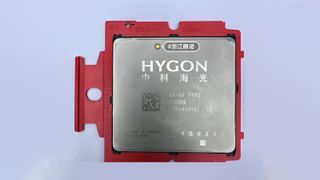China's new Hygon CPU spotted with 64 Zen cores — C86-7490 supports 12-channel DDR5 memory and resides in AMD SP5 socket
Sugon has found a way to port Zen to AMD's SP5 platform.

Sugon's 4th Generation Hygon processor uses AMD's latest SP5 packaging, according to a finding by hardware leaker YuuKi_AnS. A quick Google search reveals that the CPU resembles AMD's latest Zen 4-based processors in terms of memory and interface support. However, the Chinese company has likely just adopted new packaging to gain features like DDR5 memory support.
Apparently, Hygon has a processor called C86-7490, which is available on a Chinese online auction. The unit is slightly scratched, as can be observed in the picture. The package says that the product was 'Designed in Chengdu' and 'Made in China,' though this was the same with the first generation Hygon CPUs based on the Zen microarchitecture. While the silicon dies were made in the U.S. by GlobalFoundries, they supported China-specific SM3 and SM4 encryption algorithms disabled on AMD-badged parts and assembled in China, formally allowing Hygon to say that they were designed and made in China.
Technically, while Sugon's Hygon C86-7490 comes in AMD's most recent SP5 packaging for data center-grade processors, it does not necessarily mean that they use the red company's more recent chiplets based on Zen 4 or Zen 5 microarchitecture. However, a Google search quickly leads us to a Chinese server maker that offers 2-way and 4-way Hygon C86-4G-based machines with 48 DDR5 memory slots, which in the case of a 4-way machine means 12 memory slots per CPU and, coincidentally, AMD's EPYC CPUs in SP5 packaging have 12 memory channels.
Technically, this could only mean that Sugon has found a way to attach first-generation Zen chiplets to AMD's latest input/output dies (IODs) with a DDR5 memory controller.
While U.S. sanctions prevent sales of advanced processors to China, there are no curbs that prevent the shipping of highly advanced IODs and platforms to China. Meanwhile, re-architecting SP5 for AMD's original chiplets probably requires much engineering effort. Furthermore, mating the original Zen chiplets made using a 14nm-class process technology with an N6 (6nm-class) based IOD for AMD's latest Zen 4-based CPUs is problematic due to highly different voltages.
Regarding the political curbs of the U.S. government, there are particular performance limitations defined by the performance of essentially a piece of silicon. AMD can configure its chiplets to meet U.S. export requirements in terms of performance, and then assembling actual CPUs in China is hardly a problem for Sugon.
While we can never be 100% sure what is under the heatspreader of Sugon's Hygon 4G processors, we may say that these processors use some of AMD's most advanced technologies. As for which, time and further leaks will tell.
Stay On the Cutting Edge: Get the Tom's Hardware Newsletter
Get Tom's Hardware's best news and in-depth reviews, straight to your inbox.

Anton Shilov is a contributing writer at Tom’s Hardware. Over the past couple of decades, he has covered everything from CPUs and GPUs to supercomputers and from modern process technologies and latest fab tools to high-tech industry trends.
-
Geef Using AMD's socket sounds like a good plan for China's new chip. They will get around the sanctions while still using high end gear.Reply
Think of it like using a totally brand new high end system but using a few generations old chip. The chip may be a bottleneck but it's a known bottleneck and can be worked around. Even an older/slower chip still runs most games great... Oh wait...
Cancel everything I said, China has rules about gaming so owning your own awesome PC there is worthless. I mean really, what other reason could there be for a PC than to play games?!?
:p
Most Popular



